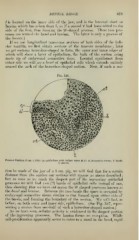Page 609 - My FlipBook
P. 609
DENTAL RIDGE. 619
I is located on the inner side of the jaw, and is the internal sheet or
lamina which has arisen from b, as if a second V had been added to the
side of the first, thus forming the W-shaped process. These two pro-
cesses are termed the band and lamina. The latter is only a process of
the former.)
If we cut longitudinal transverse sections of both sides of the infe-
rior maxilla, we first obtain sections of the mucous membrane ; later
we get sections horseshoe-shaped in form, the outer and inner edges of
which will show a layer of epithelium, the bulk of the section being
made up of embryonal connective tisue. Located equidistant from
either side we will see a band of epithelial cells which extends entirely
around the arch of the horseshoe-shaped section. Now, if such a sec-
FiG. 346.
Porcine Embryo (3 cm. X 250) : ep, epithelium with infant layer at ii; ct, connective tissue; 6, band;
I, lamina.
tion be made of the jaw of a 3 cm. pig, we will find that for a certain
distance from the surface our sections will apj^ear as above described
;
but as soon as we reach the deepest part of the ingrowing epithelial
proces.ses we will find two (2) bands of epithelial cells in.stead of one,
thus showing that we have cut across the W-sha]ied processes known as
the band and lamina. Bet\veen the two bands the space is occupied by
embryonal connective tissue similar to that formed upon either side of
the bands, and forming the boundary of the section. We will find, as
before, on both outer and inner side, epithelium. (See Fig. 347, repre-
senting a section from one-half of such a horseshoe-shaped section.)
As we have seen, cellular activity is evidenced in the deepest portion
of the ingrowing processes. The lamina forms no exception. While
cell-proliferation apparently seems to come to a stand in the band, rapid


